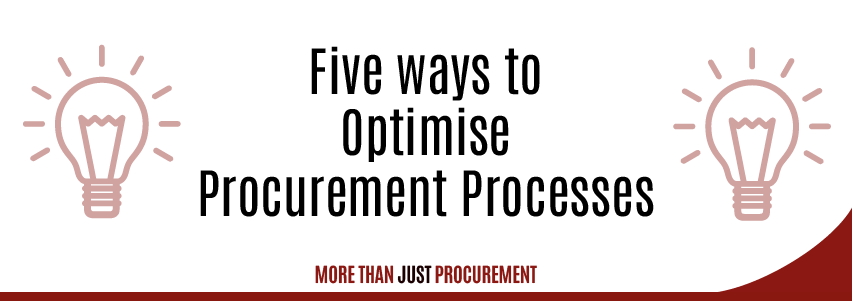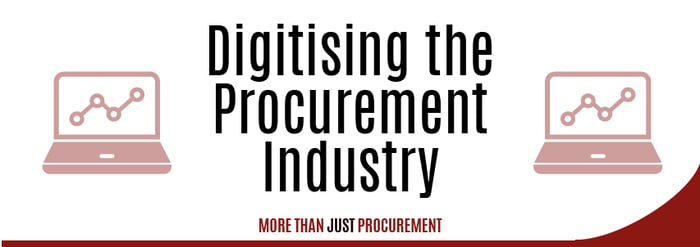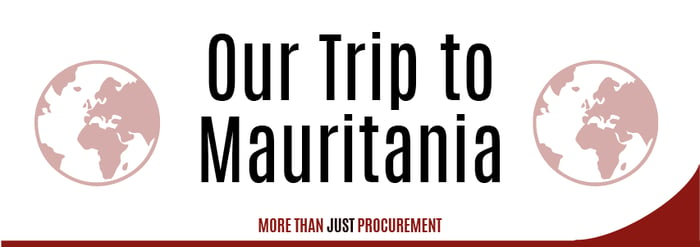5 Ways to optimise procurement processes
Tips & Tricks • 3 min read • Sep 28, 2022 8:25:56 AM • Written by: Amelia Inskipp

The role and end goal of procurement’s functions is to optimise the process of adding value to a business, whether this is through goods or services, leading to a wealth of benefits.
Since the process of procurement affects every department within a business and impacts revenue, the operations of procurement need to run as efficiently as possible, by regularly reviewing its processes and developing on it.
So, we know why procurement is important for the functions of a business, but why does it need to be optimised?
One of the most notable benefits when optimising procurement is the cost advantages it delivers. When effectively managing procurement, organisations make cost savings by sourcing items and services at the best price.
Procurement can also allow for better visibility to see a company’s spending and budget. This can help plan for better contracts and improve spending habits. This will lead to further cost savings by negotiating terms with vendors, allowing them to take advantage of discounts.
However, optimising procurement can be difficult with many companies often sourcing professionals. These specialists enhance practices, ensuring effective management and a strong line of communication is occurring. If this does not proceed, then inconsistencies can arise, wasting time and money.
There are several ways to optimise our processes, but in this post, we will discuss five important aspects that will help elevate your business.
Digitalisation
If you are not completely digital when optimising your procurement strategy, then you are already behind. Most companies now ensure their category management and procurement processes are digital. Digitalising procurement can allow for clearer visibility through having online access to reports such as spend analysis and contracts.
Technology can drive efficiency in the workplace by automating repetitive tasks. This frees up valuable resources whilst also reducing the possibility of errors. It also gives clients complete transparency of processes taking place and day-to-day decisions. Delivering clarity can enhance relationships between buyer and supplier by driving better collaborations.
Vendor Management
Establishing connections with suppliers and nurturing long-term relationships is key to optimising a procurement strategy. Deciding the right vendor for your business is crucial as choosing one that disappoints can have a knock-on effect.
Executing appropriate management allows for a larger selection of vendors equalling more choice and better costs. This means you are in control as you can ensure you are getting the best price for your business resulting in long-term savings. A vendor management system also gives your organisation an overall view of the best practices for your company, enabling an efficient decision-making process, saving time and money.
Evaluating vendors will allow your company to ensure that needs met. This can be evaluating the products they produce, the prices they offer and how efficient the relationship works.
Use Data
When looking to optimise a procurement process, information is key to collect and analyse data. Analytics can affect all parts of procurement whether it is procure-to-pay (p2p) processes or category management. It can help to identify cost savings and prioritise suppliers whilst also focusing on risk opportunities.
Data management can help optimise practices in inventory by clarifying where costs can be managed and sometimes saved whilst also ensuring stock levels are at an ideal point. Too much stock will mean wasted costs on storage and too little can cause problems with customers.
Analysing data can help you to achieve the best out of your business. External as well as internal procurement is key. Evaluating supplier performance, looking at contract management as well as internal spend analysis is crucial. This can allow budget planning, gaining insight on performance and discovering new opportunities to highlight.
Transparency
Transparency implies that a business has effective communication skills and is open about what and how systems are performed, whether this is vendor management, purchase decisions or invoices. Maintaining transparency in purchasing processes is vital to utilising cost savings across the whole company and ensuring communication and accountability take place. It builds trust that is essential for any future relationships between businesses and suppliers. This can be done through publicising documents of all processes and decisions to ensure complete clarity. Not only does it introduce cost savings but also allows visibility of late or duplicate payments and discounts.
Staff Development
Employees are essential to the process of procurement, so ensuring that they are conducting procedures correctly is key to the smooth running’s of operations. Educating staff about company products, services and practises means they are fully equipped to complete projects to the standard the business expects, as well as diffuse problems before they escalate.
This can be done BY having a standardised procurement process. This means adopting specific approaches in consensus across the whole business. This gives companies a competitive edge, leading to lowers costs and customer satisfaction. Training employees about these processes will also lead to less careless spending and ensures uniformity across the business
Using Storm Procurement for your procurement management means you already have an optimised procurement model in place. Do not waste your time researching how to enhance your operations, we do this for you.
What are you waiting for?
Reach the World. Giving Made Easy with Impact.
Amelia Inskipp
Related Articles

Tips & Tricks
Digitising the process of procurement

Business News
Mining Processes: Placer Mining

Business News
Our Trip to Mauritana
Don't Miss Out On A Thing
Sign up and Join Our Newsletter Today